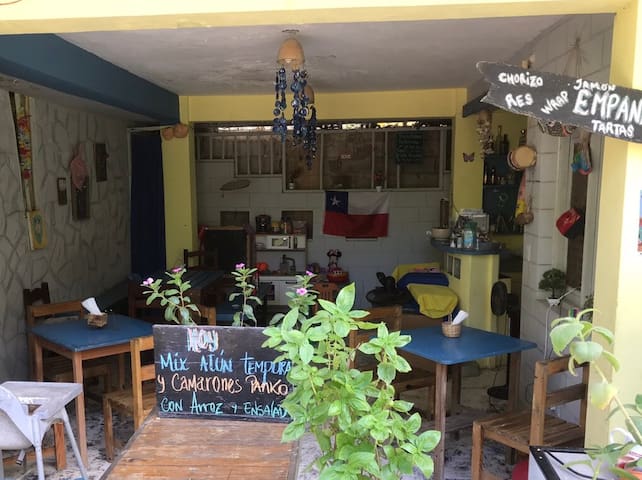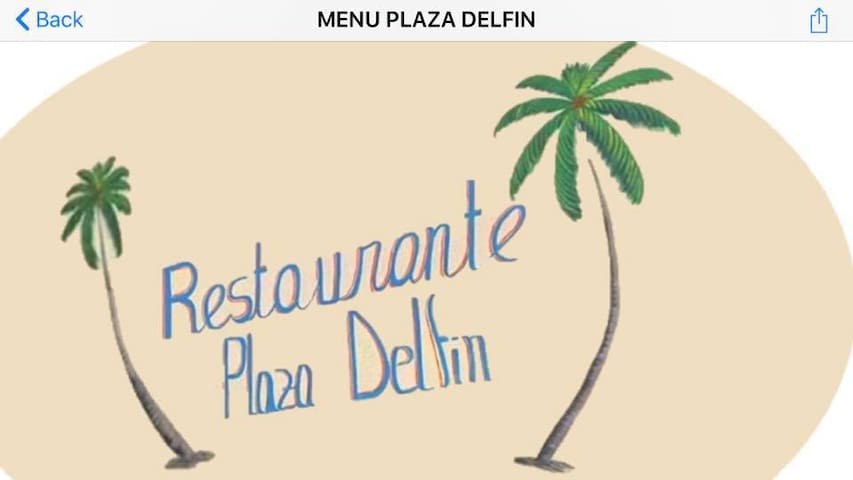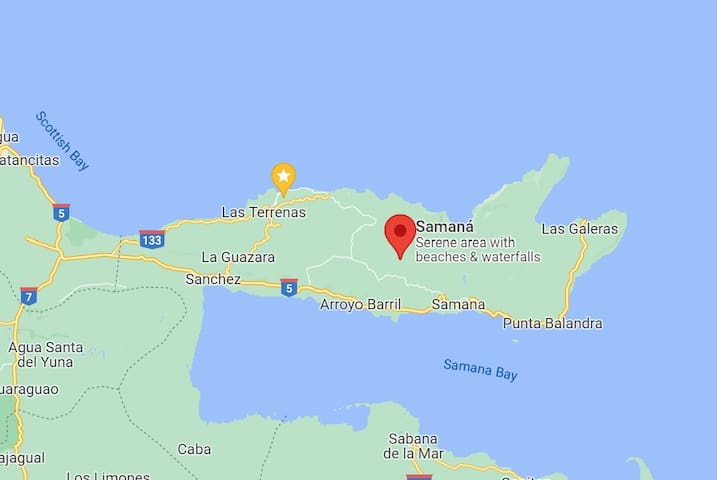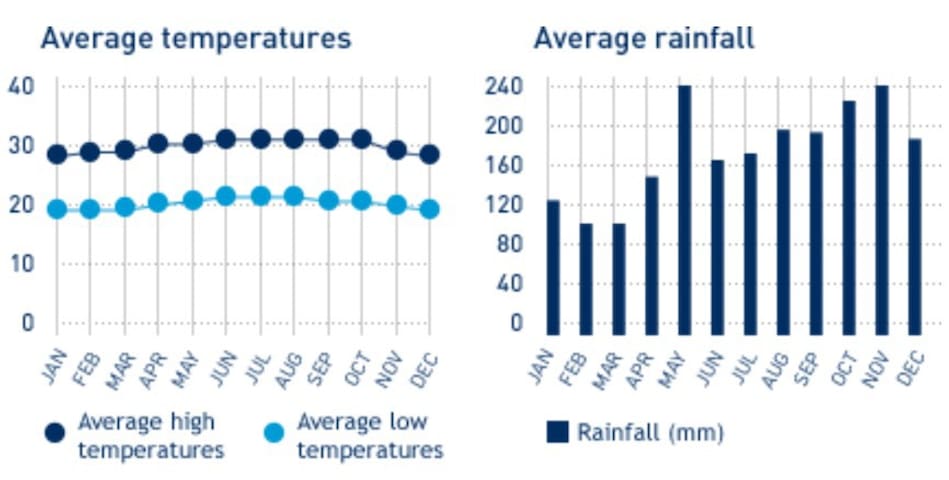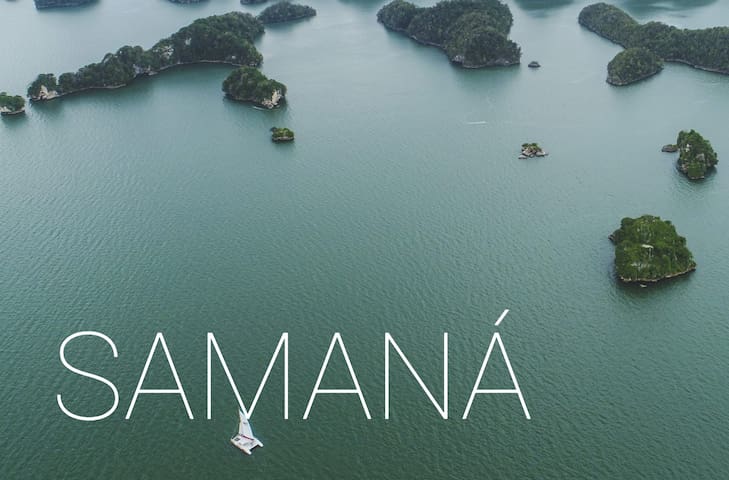Food scene
EMPANADA Y MAS is on our road and without any doubt they are the best empanadas in town. Pepe and Ivonne are wonderful and their food is simply amazing!
Empanadas y más
Pedro Francisco BonoEMPANADA Y MAS is on our road and without any doubt they are the best empanadas in town. Pepe and Ivonne are wonderful and their food is simply amazing!
Delicious Food, Excellent Service and Extremely Friendly! Isaac makes you feel like family and will treat you to a culinary experience! The food is incredible and ambience is perfect! Don't miss out on this local family restaurant. You will not be disappointed!!
7 íbúar mæla með
Restaurante Plaza Delfin
3 Pedro Francisco BonoDelicious Food, Excellent Service and Extremely Friendly! Isaac makes you feel like family and will treat you to a culinary experience! The food is incredible and ambience is perfect! Don't miss out on this local family restaurant. You will not be disappointed!!
Grocery Shopping
Sirena Supermarket. You’ll find all of the typical groceries here as well as an assortment of household items and kitchenware. They have a good selection of fruits, vegetables, meats and cheese, bread, dairy, etc. If you spend over $5000 Pesos you will get free delivery right to your door.
121 íbúar mæla með
Supermercado Pola
Calle DuarteSirena Supermarket. You’ll find all of the typical groceries here as well as an assortment of household items and kitchenware. They have a good selection of fruits, vegetables, meats and cheese, bread, dairy, etc. If you spend over $5000 Pesos you will get free delivery right to your door.
Grocery Store with plenty of imported and good quality native brands, fresh produce, meats, dairy, etc. Good service with a great selection of food and wine. A little more expensive than Super Pola however you can find some unique imported items here that you won't find at Pola. You have to bring your own bags for groceries.
108 íbúar mæla með
Super Mercado Lindó
Calle DuarteGrocery Store with plenty of imported and good quality native brands, fresh produce, meats, dairy, etc. Good service with a great selection of food and wine. A little more expensive than Super Pola however you can find some unique imported items here that you won't find at Pola. You have to bring your own bags for groceries.
Destination Basics
What makes it different - The Samana peninsula region has the largest concentration of coconut palm trees in the world. The beautiful coral beaches of fine golden sand are generously sprinkled with them. The turquoise waters stay warm year-round, always beckoning you to jump in for a swim. All you have to do is put on your swimwear and pick a beach.
Bonita Beach is ideal for learning how to surf, while the six-km-long Playa Coson beach has something for everyone – a bay of calm waters, river mouths, strong winds for kite enthusiasts and waves for surfing. El Portillo Beach offers calm, shallow waters that are attractive for family outings. And the remote Playa Rincon beach was voted second best in the world by Conde Nast Traveler.
The Samana Bay (Bahia de Samana) is also one of the top places in the world to see humpback whales in action. Every year, from January to mid-March, thousands of these huge mammals come from faraway waters. It’s here where female humpback whales are courted by the males, mating and a year later, giving birth to their babies. The balmy, shallow waters of the bay provide the perfect conditions for delivering the baby humpbacks.
But there are many reasons to visit beyond the whale-watching and gorgeous beaches. Samana is filled with authentic culture and history. The area has been home to many different ethnic groups and their influence remains strong here. You’ll see menus in French at local restaurants and hear people conversing en francais in Las Terrenas. In El Limon, the Anglo-Saxon surnames of King, Kelly and Jones are commonplace. And in Santa Barbara de Samana, you may hear gospel psalms in an English/Spanish blend – a fascinating experience.
There are also plenty of activities for active vacationers to enjoy. A visit to Los Haitises National Park and a horseback ride to the El Limon Falls are sure to create memories of a lifetime. Surfers and kitesurfers will find challenges in the perfect combination of winds and currents off-shore of Samana. If you opt for snorkelling and scuba, you’ll find bliss in the seabed teeming with marine life and colourful coral.
This is also a place where you can mingle with locals. Go to the open-air produce market at Santa Barbara de Samana and hear pleasant greetings with friendly smiles. Rub shoulders with locals on the bustling streets of Las Terrenas. Bargain for a boat ride with the fishermen at Las Galeras. You’ll soon fall into the rhythm of the land and be accepted as part of it.
92 íbúar mæla með
Samana
What makes it different - The Samana peninsula region has the largest concentration of coconut palm trees in the world. The beautiful coral beaches of fine golden sand are generously sprinkled with them. The turquoise waters stay warm year-round, always beckoning you to jump in for a swim. All you have to do is put on your swimwear and pick a beach.
Bonita Beach is ideal for learning how to surf, while the six-km-long Playa Coson beach has something for everyone – a bay of calm waters, river mouths, strong winds for kite enthusiasts and waves for surfing. El Portillo Beach offers calm, shallow waters that are attractive for family outings. And the remote Playa Rincon beach was voted second best in the world by Conde Nast Traveler.
The Samana Bay (Bahia de Samana) is also one of the top places in the world to see humpback whales in action. Every year, from January to mid-March, thousands of these huge mammals come from faraway waters. It’s here where female humpback whales are courted by the males, mating and a year later, giving birth to their babies. The balmy, shallow waters of the bay provide the perfect conditions for delivering the baby humpbacks.
But there are many reasons to visit beyond the whale-watching and gorgeous beaches. Samana is filled with authentic culture and history. The area has been home to many different ethnic groups and their influence remains strong here. You’ll see menus in French at local restaurants and hear people conversing en francais in Las Terrenas. In El Limon, the Anglo-Saxon surnames of King, Kelly and Jones are commonplace. And in Santa Barbara de Samana, you may hear gospel psalms in an English/Spanish blend – a fascinating experience.
There are also plenty of activities for active vacationers to enjoy. A visit to Los Haitises National Park and a horseback ride to the El Limon Falls are sure to create memories of a lifetime. Surfers and kitesurfers will find challenges in the perfect combination of winds and currents off-shore of Samana. If you opt for snorkelling and scuba, you’ll find bliss in the seabed teeming with marine life and colourful coral.
This is also a place where you can mingle with locals. Go to the open-air produce market at Santa Barbara de Samana and hear pleasant greetings with friendly smiles. Rub shoulders with locals on the bustling streets of Las Terrenas. Bargain for a boat ride with the fishermen at Las Galeras. You’ll soon fall into the rhythm of the land and be accepted as part of it.
Climate - The temperature in Samana is typical of the semi-tropical weather enjoyed throughout the Dominican Republic. But it has more precipitation than most of the country. Tropical showers can occur at any time here but are usually brief. Warm sunshine soon returns, even during the rainiest time of year.
The best weather in Samana is found in winter between December and May. Winter weather is a few degrees cooler than summer and there is less humidity.
Keep in mind that temperatures are considerably cooler if you take an excursion to the region’s mountainous interior, especially in the winter. In other words, come prepared with a sweater or light jacket.
Average monthly temperature and average monthly rainfall diagrams for Samana
92 íbúar mæla með
Samana
Climate - The temperature in Samana is typical of the semi-tropical weather enjoyed throughout the Dominican Republic. But it has more precipitation than most of the country. Tropical showers can occur at any time here but are usually brief. Warm sunshine soon returns, even during the rainiest time of year.
The best weather in Samana is found in winter between December and May. Winter weather is a few degrees cooler than summer and there is less humidity.
Keep in mind that temperatures are considerably cooler if you take an excursion to the region’s mountainous interior, especially in the winter. In other words, come prepared with a sweater or light jacket.
Average monthly temperature and average monthly rainfall diagrams for Samana
Geography - The Samana peninsula is located in the northeastern part of the Dominican Republic, between Samana Bay (Bahia de Samana) and Scottish Bay (Bahia Escocesa). It extends 58 km west to east. A slender peninsula, its minimum width is 7.5 km, from the gateway town of Sanchez to the north shore. Its widest point is 18.5 km, from Los Cacaos in the south to Las Tres Puntas in the north.
With a land mass of 850 sq. km., it’s a comfortable size and easy to explore in a week. Its topography is similar to an upside-down egg carton with low, rugged mountains covering much of the peninsula.
The mountains in the western extreme are separated from the Cordillera Septentrional mountain range by an extension of swampy, flat land called El Gran Estero. Hundreds of years ago, Samana peninsula was an island and this area was underwater. Deposits from the Yuna River have now filled in the land.
The mountainous interior forming the spine of the peninsula is composed of three sierras, none of them very steep. The highest mountains are La Meseta or Monte Mesa, at about 605 metres above ocean level. Numerous streams and rivers run down these mountains, some in spectacular waterfalls. Much of the interior land is farmed for coconut, rubber, coffee and cocoa, as well as seasonal crops such as yucca.
With the exception of the island of Cayo Levantado to the south, the best beaches are mostly found on the north side of the peninsula.
92 íbúar mæla með
Samana
Geography - The Samana peninsula is located in the northeastern part of the Dominican Republic, between Samana Bay (Bahia de Samana) and Scottish Bay (Bahia Escocesa). It extends 58 km west to east. A slender peninsula, its minimum width is 7.5 km, from the gateway town of Sanchez to the north shore. Its widest point is 18.5 km, from Los Cacaos in the south to Las Tres Puntas in the north.
With a land mass of 850 sq. km., it’s a comfortable size and easy to explore in a week. Its topography is similar to an upside-down egg carton with low, rugged mountains covering much of the peninsula.
The mountains in the western extreme are separated from the Cordillera Septentrional mountain range by an extension of swampy, flat land called El Gran Estero. Hundreds of years ago, Samana peninsula was an island and this area was underwater. Deposits from the Yuna River have now filled in the land.
The mountainous interior forming the spine of the peninsula is composed of three sierras, none of them very steep. The highest mountains are La Meseta or Monte Mesa, at about 605 metres above ocean level. Numerous streams and rivers run down these mountains, some in spectacular waterfalls. Much of the interior land is farmed for coconut, rubber, coffee and cocoa, as well as seasonal crops such as yucca.
With the exception of the island of Cayo Levantado to the south, the best beaches are mostly found on the north side of the peninsula.
Borgartillaga
Siðir og menning
Samana Peninsula
More than ever Las Terrenas and the Samana peninsula stand out and are confirmed as one of the most attractive destinations in the Dominican Republic. Naturally restricted by limited hotel and rental capacity, the destination escapes to mass tourism and the visit of its beautiful and inescapable tourist places remains very privileged. Walking along beaches of several kilometres makes perfect sense! The discreet peninsula of lush nature offers its visitors a priceless luxury, a true piece of paradise with magnificent and often unspoiled beaches and humpback whales in winter.
Siðir og menning
Las Terrenas
The most visited and developed section of Samana, Las Terrenas is the perfect blend of a dreamy beach village and a cosmopolitan town. It’s waterfront boasts multiple stunning beaches, as well as a variety of small hotels, international bistros, apparel and arts and crafts boutiques, local restaurants and lively bars. While the white sand beaches located right in town are good for a swim, the surrounding Playa Bonita and Playa Coson will take your breath away, perhaps as much as the delicious seafood caught fresh and served on site. Nights come alive in Las Terrenas with dancing and bars
Ekki missa af
Komida ! App for your phone
Great App to add to your phone so that you can order for home delivery! You can order from a variety of Restaurants, Supermarkets, Liquor, Flowers, Desserts, Pharmacy and Services
Siðir og menning
Culture
On very old maps, the Samana peninsula is sometimes shown as an island. There was once a channel here that reached all the way up to the north coast from Samana Bay (Bahia de Samana), creating a marshy waterway across the neck of the peninsula. Pirates used this channel as an escape route from the Spanish. Hundreds of years later, this marshy area is now fertile land near the town of Sanchez.
Yet even today, Samana still seems cut off from the rest of the Dominican Republic. Its culture is a unique blend of various ethnic groups. The Taino, Ciguayos and other natives were the first occupants.
Samgöngur
Transportation
Rental cars are available at the airport as well around your resort. However, please proceed with caution if you do decide to rent a car in Samana. Driving conditions here are unlike North America. The roads are narrow and rough, especially around the peninsula, and not lit. Driving at night time is not recommended due to poor visibility.
Overall, the best way to travel throughout Samana and surrounding areas is by taxi. The drivers here know the area extremely well and will help you get to and from destinations with ease.
Sparnaðarleiðir
Currency
The official currency of the Dominican Republic is the Dominican Peso. Most hotels, restaurants and businesses accept major credit cards. If you would prefer to have cash on hand, both Canadian and U.S. money can be exchanged for the peso during your stay at both banks and exchange booths (called casas de cambio). Most hotels and resorts also offer currency exchange services.
If you need to withdraw funds, you’ll find bank machines at many resorts and popular shopping areas. Please note that local ATMs only dispense funds in pesos and fees vary by machine.
Hvað á að taka með
Voltage
Electricity in the Dominican Republic is 110 volts, and can fit most (two-pronged) North American plugs. However, some hotels may operate using Swiss outlets - which are round pins instead of flat pins. If you are bringing an electrical appliance, it is recommended that you verify prior to departure if a converter and/or adaptor is required.
Bókaðu áður en þú leggur af stað
Vaccinations
Be sure your routine vaccinations are up to date. Hepatitis A, hepatitis B, malaria, typhoid and tetanus are commonly recommended by the Public Health Agency of Canada. Check with your local healthcare provider for additional information.
Siðir og menning
Baseball
Baseball is the Dominican Republic’s favorite sport. For Dominicans, “pelota”–as we call it here–is more than a sport. It’s a limitless passion, a love for country and unity. For the young generation, baseball also symbolizes a dream and hope for a better future–with the possibility of becoming one of the world’s legendary Dominican baseball players. After all, it worked for Sammy Sosa, Pedro Martínez, David Ortiz, Robinson Canó, José Reyes, Juan Marichal and Bartolo Colón, among numerous others.
Aside from tracking their favorite players during the Major League Baseball (MLB) games, each Dom
Siðir og menning
Music
Dominicans are renowned for their dancing talents–you will spot them spontaneously twirling at the park, on their house veranda, or pretty much anywhere they hear their music. The DR’s sounds and instruments are influenced by West African, Spanish, and European roots. Two principal genres dominate and are synonymous with the Dominican Republic, here and around the world: merengue, and bachata. But there’s also son and a multitude of folkloric dance and music. Wherever you end up in the Dominican Republic, experiencing our music and our rhythms is as easy as stepping outside.
Siðir og menning
Carnival
Dominican Carnival–carnaval dominicano–is the most vibrant celebration of Dominican culture and identity. It’s a time when Dominicans of all ages and from all regions take to the streets, at home or in neighboring carnival cities, to enjoy parades with their families and loved ones.
Every Sunday during the month of February, colorful parades take place in every major city and region around the DR–some extending through the first week of March. La Vega Carnival is the oldest, largest, and most popular of all, followed by Santiago.

